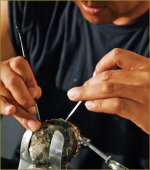Now based on the above, I conjectured two possible source of pearls the first is considering that the countries of the Arabian Gulf are endowed with pearl oyster resources that have been exploited for natural pearls from time immemorial, and they have depended on these marine economic resources. Egyptian women had pearls in their jewellery as early as 1,500 B.C. and the early Arabian geographer Massoudi noted the existence of Gulf pearls in the 9th century (SHARABATI 1981). As early as the 3rd century B.C., Nearchus reported that, in the Red Sea, pearls occur most extensively around the Dahlak and the Farasan Islands in the southern part of the Red Sea (SHARABATI 1981). (Torsten Wronski, 2010)
Then, in 1500BC, Egypt already had a blooming trade with Afghanistan, Pakistan and the Indus Valley Civilization, could it be that early Egyptian women wore pearls issued from trade with India?
The second possible source is that the pearls in question (40BC) originated from the Red sea, that is from natural seabed of either Pinctada radiata or from Pinctada margaritifera (Linnaeus, 1758), (also referred to as Meleagrina margaritifera or Pteria margaritifera). (Hasan, 1974 and 1983) (AL-KHAYAT & AL-ANSI 2008).
References to Alexandria being suitable for this species tend to confirm the above.
The distribution of the population shows that Pinctada radiata represent 95% of the natural population with a distinct predominance from shallower water than Pinctada margaritifera. The later shares the deeper water with Pteria aegyptiaca (Dillwyn, 1817). I do not know how deep could divers go 40BC but logic tends to point to pearl produced by Pinctada radiata, but again this is a conjecture...
It seems as well that the Farasan islands are predisposed as a perfect biome for the pearl producing species above mentioned. Descriptions make mention of high salinity, constant temperature and presence of Avicennia spp. or Rhizophora spp., mean to say fast growth rate expected...





